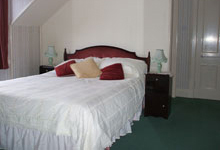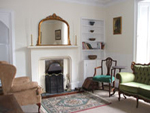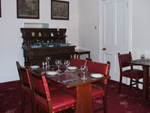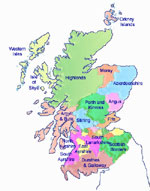Craigard House is an early Victorian House (1840) set
centrally in the Scottish Highlands in picturesque Glengarry on the edge
of Invergarry village. Offering bed and breakfast with an option of an
evening meal, it is an ideal base for visiting the many attractions of
the Highlands.
The house has retained many original features, most of the bedrooms have
their cast iron fireplaces with stone fire surround intact. The lounge
and dining room still have their original wooden shutters and in the lounge
the victorian owners, husband and wife have signed the window pane!
![]() Email Craigard House enquiries & reservations: bookscotland@madbookings.com
Email Craigard House enquiries & reservations: bookscotland@madbookings.com

![]() Other places to stay in Invergarry
Other places to stay in Invergarry

A Victorian House with many original features, set in the breathtaking
splendour of the Highlands, we are on the western outskirts of the village
of Invergarry, which is located in the heart of the highlands. We offer
bed and breakfast with an option of an evening meal by arrangement.
Craigard House is the perfect base for a varied holiday exploring what
this area has to offer. If your interest is History, Walking, Wildlife,
Cycling, Fishing, Plant Life, Photography, Art, Geology or just admiring
the scenery of Glengarry there is something here for you.
The central location of Craigard House is ideal, as the southern end
of Loch Ness is 8 miles, Urquhart Castle 25 miles to the northeast. To
the southwest Ben Nevis and the Jacobite Steam Train are 25 miles. Westwards
Eileen Donan Castle is 42 miles and the Isle of Skye just 8 miles further.

We also provide the following facilities, an evening meal by arrangement,
WIFI available in the guest lounge and most of the guest bedrooms, packed
lunches, a TV in all guest bedrooms, secure cycle storage, a drying room.
The Guest Lounge is a spacious room, south facing, looking
out across the fields towards the River Garry. The room is decorated with
original Victorian oil paintings and prints. Furnishing is a mixture of
classical modern and victorian. Plans for this winter include the upgrade
of the fireplace, which is not original, with a wood burning stove, so
an inviting warmth can be guaranteed in early spring and autumn.
The Dining Room again a south facing room, with original shutters to the bay bay window. The room is bathed in sunlight for breakfast in summer and is an ideal place for a quiet relaxing evening meal.
Bedrooms, 7 in total, 3 doubles, 3 twins and a single.
Most have original Victorian fireplaces and one has wooden shutters. Five
of the rooms are en-suite and two rooms, a double and a twin share a bathroom,
although there are plans to put an en-suite into one of the rooms this
winter.
Craigard House is located on the western edge of Invergarry, on the road
to the Kyle of Lochalsh/ Isle of Skye.
Directions:
From the South, from Fort William travel north on the A82 for 25 miles,
at Invergarry turn left onto the A87, signposted Kyle of Lochalsh. Once
you pass the Community Centre on the left, Craigard House is about 500m
on the right, there is a sign on the roadside.
From the north, from Inverness travel on the A82 for 38 miles and turn
right in Invergarry onto the A87 signposted Kyle of Lochalsh, and follow
as above.
From the West, from the Kyle of Lochalsh follow the follow the A87 at
Bridge of Moriston turn right, still on the A87 for 13 miles, Craigard
House is the first building on the left after the village tourist sign.
There is a great choice of walks, from the strenuous Munro bagging, there are 66 within 1 hr and 31 within 30mins drive, to delightful woodland paths in Glengarry. There are several walks from Craigard House itself. Plus the Great Glen Way is only a couple of miles away and if you are completing this walk without transport we can prearrange a pick up and drop off from Loch Oich.
For the cyclist, there is much choice in the routes and level of ability from mountain biking at the witches trail Leanachan or Wolftrax, Laggan or other routes in the Forests. If you are cycling the Great Glen Cycle Way or even further, we are ideally suited for a stopover.
Craigard is an excellent base for wildlife watching,
the woods and hills around contain Red and Roe deer, Red Squirrel and
Pine Martens. Otters have been spotted in the River Garry and local Lochs.
Birds of the area include Buzzards and the occasional Golden Eagle, to
Siskins and Greater Spotted Woodpeckers.
For the birdwatcher Invergarry is a useful base as our
location means that coastal, mountain and woodland environments are all
within reach.
The Isle of Skye with its Sea Eagles is well within easy
traveling distance. The Caledonian Forests of Glen Affric (40 miles),
the RSPB reserves of Corrimony (38 miles) and Loch Ruthven with its Slavonian
Grebes is about 31 miles away.
Fishing - Trout and Salmon permits are available locally
for fishing the River Garry and Loch Oich and for other local lochs. Ghillies
are also available to enhance the days fishing experience.
Walking - The highlands are renowned for the number and the variety of
the walks available. From Craigard House you do not even have to get into
the car as there are several walks into the glen or the surrounding Glengarry
forest. Plus within a short distance the upper part of the glen holds
many walks into the hills and surrounding glens. We are close by the Great
Glen Way.
Hill Walking - For those looking for a more strenous
expedition into the hills, there are over 60 Munros within 1 hr drive.
There are of course also a large number of Corbetts.
Cycling - There is an excellent range of cycling options from single track
road journeys, the Great Glen Cycle Way, forest tracks to waymarked mountain
biking routes at the Nevis range and Wolftrax.
Water Sports - The river Garry and surrounding areas
are popular canoeing areas. Close by at Loch Oich you can take part in
white water rafting, canoeing, wind surfing or water skiing. Click here
for details.
Pony trekking and Equestrian- A choice of Torlundy near Fort William,
or Drumnadrochit for a variety treks. Inverness Equestrian Centre near
Dores has trekking suitable for experienced riders.
History of Craigard House
The house was first built in the 1840's and occupied by the Rhodes family
at about that time, theyt had worked initially as carpenters on the Caledonian
canal with Thomas Telford. James Rhodes, was appointed Canal Superintendent
at Invergarry. The family were originally from the Bradford area. A substantial
amount of land was associated with the house as the family were also involved
in farming. Not much evidence remains of the farm, the building to the
side of the house is the old cowshed, there are also some buildings in
the area, such as an old gamekeepers cottage.
In the 1860's the family sold the house and it was incorporated into the
Glengarry estate by the Ellice family. At this stage it ceased to be a
farmhouse and became the factors house and office. At about this time
the only major alteration to the building took place, the rear part of
the building was extended upwards to create an extra room above what was
the Factors offices. The proch was also added at about this time. The
Factor, George Malcolm, lived here for over 30yrs, he was viewed with
a great deal of respect within the community. Although the office part
of the house is now the private accommodation the office nature of the
rooms is still very much in evidence.
The house stayed within the estate until the 1940's when it was sold to
the government department developing the hydro schemes in the glen and
surrounding area. It then became the engineers offices. It became a guest
house in the late 1960's.
An insight into changes in the technology came to light this year when
part of the roof guttering was replaced, a section from 1840 and another
from the 1870's addition. The galvanised nails from 1840 were all clearly
handmade, each different and square in section, by 1860 they were all
machine made. However both sets of nails were retained as they were in
almost perfect condition and used in the replacement lead work. So they
are there probably for another 160 years!
History of Glengarry
For getting the most out of your visit to Glengarry there is an excellent
Heritage Centre in the Community Hall, some 500m from Craigard House,
which has material and documents relating to the archaeological and historical
development of the glen. To visit their web page click here
The history of the glen largely mirrors the wider history of the Highlands
with clan disputes, rebellions and then emigrations and finally a rich
landlord. The glen is very much associated with the clan MacDonnell, stretching
from the late 14th century through to the 19th century when the land was
sold. During this period Invergarry castle was built and then subsequently
ruined a couple of times. It stands today as a ruin on the shores of Loch
Oich, work is currently continuing to stabilise the ruins. The MacDonnell
period was marked, as is other parts of the Highlands by bloody inter
clan fighting and rebellions for and against the crown. MacDonnell ownership
came to an end as a result of mismanagement, it was then sold to Edward
Ellice.
The Ellice family had made a fortune in Canada with the fur trade. By
the time the Ellices took over the glen most of the population had been
forced out to make way for sheep under the MacDonells stewardship. Unlike
many other glens that were taken over by incoming landlords the Ellice
family went about building what could be termed a "model" village.
In this period you had no need to go out of the glen for anything. The
Ellice family built a bank, village hospital, village store, tailors shop,
church and school.
The nephew of the original purchaser of the estate also an Edward Ellice,
took a great deal of interest in the people and history of the glen. He
learnt Gaelic and as a result wrote a book "Place Names of Glengarry
and Glenquoich”. A book that in typical victorian fashion also details
the natural history of the glen, so it is more than just a list of place
names. Its importance is in preserving the gaelic place names which were
being lost as emigrations and the resulting depopulation took its toll
on the collective memory. He alone at the time recognised the importance
of having a written account. As a result Glengarry has a record that is
unique among the glens of the highlands.
